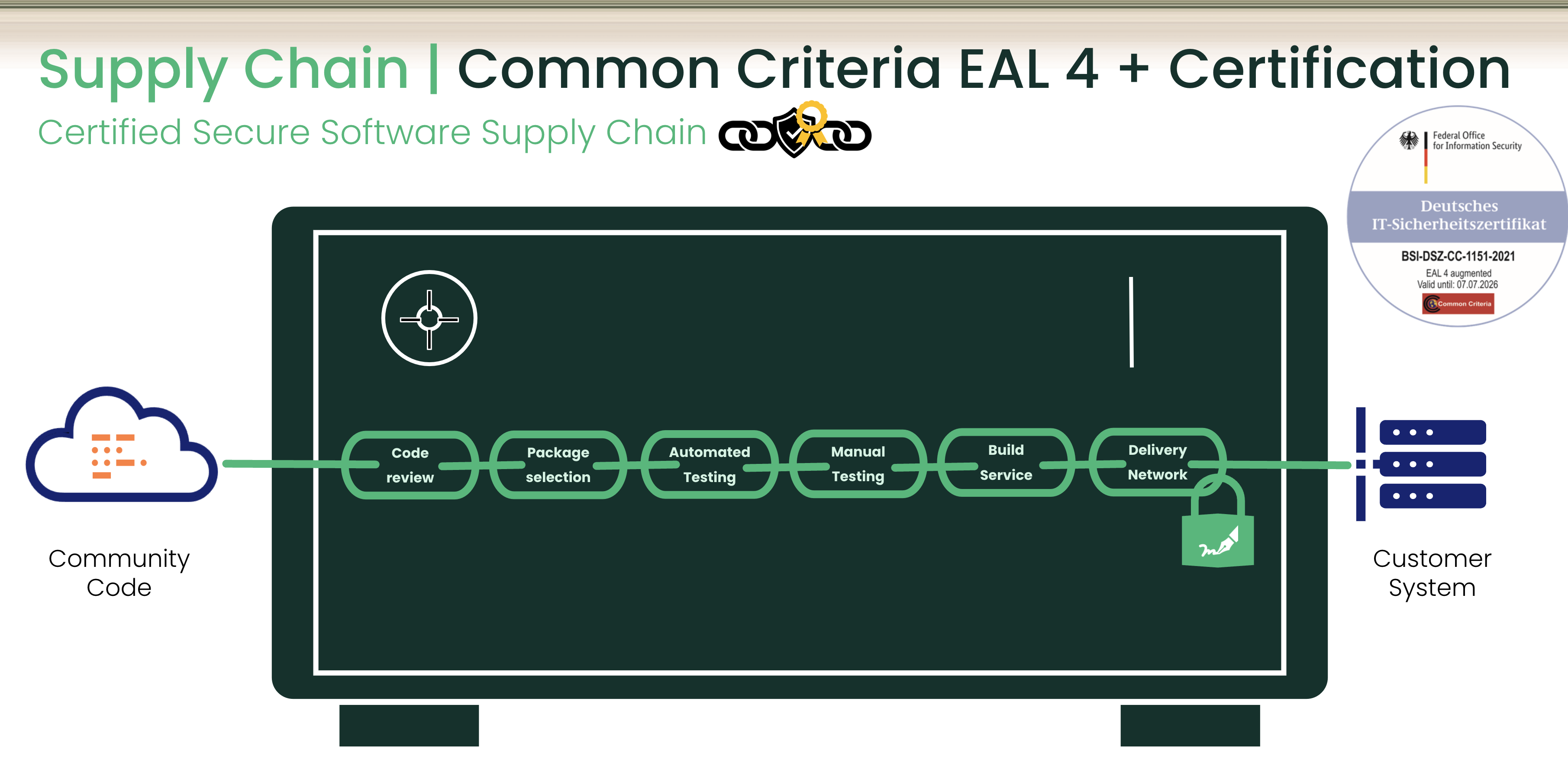An Enterprise Linux Platform is the choice for Security and Compliance in IT
Organizations tend to limit the use of enterprise Linux to only critical workloads in their Linux environment while treating other workloads as secondary citizens in their IT. However, compliance and security must be considered when managing all types of workloads. SUSE Linux Enterprise Server (SLES) has a unique level of certifications and a security approach that helps organizations achieve a secure and reliable IT operations environment.
Introduction
In today’s digital landscape, where open-source technologies are at the core of innovation, choosing a Linux distribution goes beyond mere functionality. Enterprises are tasked with ensuring the utmost security and compliance, especially regarding critical applications, but they also must apply to internal developments and emerging deployment models like containers. This blog delves into why organizations should consider a certified Enterprise Linux, like SLES, as their default Linux distribution over free alternatives, like Debian or Ubuntu, or the use of non-curated libraries downloaded directly from community repositories, emphasizing the significance of a certification-evaluated Secure Software Supply Chain.
What is offered by an Enterprise Linux
An enterprise Linux offers more than just support and patches for Linux. It provides compliance and security as well. It gives access to a curated set of enterprise-supported open-source libraries, container images, and development tools that are essential for modern organizations. The benefits of enterprise Linux are numerous and include long life cycles that can meet the needs of any IT system. Specifically, for those systems and devices needing to be supported over decades, enterprise Linux benefits are clear because only an enterprise Linux provider like SUSE, with its unparallel Long Term Service Pack Support (LTSS) Core offering, is able to provide up to 19 years of lifecycle support for a single SLES version. Another of the most relevant benefits of an enterprise Linux distribution is security, including certifications, security patches, and vulnerability assessments among best practices and hardening guides. SUSE shows an excellent example of what to expect from such a distribution and which certifications should be expected.
Expanding Horizons of Open Source
Beyond traditional enterprise applications, open-source technologies are now foundational to containerized deployments and development workflows. However, the inherent flexibility of open-source often leads to lax security practices, with employees and departments freely utilizing “free” Linux distributions or third-party libraries and container images downloaded from community repositories without stringent oversight.
Development teams working on those scenarios that usually involve continuous delivery (CD) and continuous integration (CI), where long-term support or maintenance is not the primary concern, are more likely to undervalue the benefits of enterprise Linux. However, using a curated set of libraries, base container images, and tools provided through a certified secure software supply chain ensures the security of these components and establishes a safe and auditable foundation for development. This is becoming the only way for the organization to minimize its liability in the event of a security breach and to derisk and streamline compliance assessment and assurance, which would be critical for the business.
Furthermore, enterprise Linux providers often offer a hosted registry to simplify access to curated container images, including containers with language development environments and full and lightweight container images for container development, providing support for it. If you’re looking for a secure way to access these resources, you can check out the SUSE public-hosted registry.
Compliance needs a secure software supply chain.
Compliance regulations such as EU (NIS-2 and CRA) and US (M-22-18) now require organizations to ensure the security of their supply chains, including those of their direct providers. This responsibility requires acting with due diligence, which may involve conducting a Conformity Assessment in some instances. Essentially, companies must prove they have taken all necessary precautions to prevent security incidents in their IT services. Software Bill of Materials (SBOM), Standardized Vulnerability Handling and Reporting are now part of the minimum requirements as well as guaranteed security updates for a certain period.
Therefore, an organization is responsible for the security of its entire IT software environment, including certification and assessment of third-party software used in its IT services. This applies to the Linux operating system and all other open-source components, such as development tools, libraries, and container images.
However, this task can be complex and expensive. Qualified experts are even hard to find. Numerous liaisons with communities and circles, as well as Government Authorities, have to be set up and reliably maintained. Licenses have to be monitored, fulfilled, and carefully strategically coordinated. Hence, organizations can minimize compliance costs and potential liabilities in case of breaches by using a certified Secure Software Supply Chain software provider, like SUSE, for their Linux and open-source software and its patches. Additionally, using providers with certified procedures will minimize the occurrence of security vulnerabilities.
The Imperative Need for Enterprise-Grade Linux
Enterprise Linux is no longer an option but a necessity, particularly amidst rising cybersecurity threats. Recent events, such as the XZ vulnerability in widely used Linux software, underscore the risks inherent in solely relying on community-driven distributions.
Using “free” Linux distributions, including those considered stables such as Debian or lightweight and self-defined as secure Linux distributions such as Alpine, or relying on non-curated open-source libraries poses significant challenges and risks for organizations, particularly regarding security and compliance. Unlike enterprise-grade Linux distributions like SLES, community-driven distributions often lack the rigorous security measures and certifications required for enterprise environments. For example, SLES holds unparalleled certifications like Common Criteria (CC) Evaluation Assurance Level (EAL) 4+ , which includes all necessary measures for a Secure Software Supply Chain, assuring that the operating system and associated software components adhere to stringent security protocols. By contrast, community distributions don’t undergo the same testing and security assessments, exposing organizations to potential vulnerabilities and compliance issues.
Furthermore, leveraging a certification-evaluated Secure Software Supply Chain provider like SLES can streamline compliance efforts by eliminating the need for organizations to conduct exhaustive assessments of third-party software components for which they need to have the necessary competency and are liable. This certification ensures that the software provisioning lifecycle, including patches and updates, meets state-of-the-art security standards, reducing the burden of compliance management and enhancing overall security posture. In today’s regulatory landscape, where data protection and risk mitigation are paramount, investing in an enterprise-grade Linux solution with robust security certifications is essential for maintaining operational integrity and safeguarding sensitive information.
Addressing Security Risks with SUSE Linux Enterprise Server
SUSE Linux Enterprise Server is positioned as the pinnacle of enterprise security with the highest certifications, being the only general-purpose Linux provider with a CC EAL4+ certification. Only from Evaluation Assurance Level 4 augmented by ALC_FLR.3 the entire Secure Software Supply Chain is part of the evaluation. It ensures state-of-the-art security measures throughout the software provisioning lifecycle—from initial launch to patch development and software updates. But why does this matter?

SUSE Secure Software Supply Chain CC EAL4+ image
The Importance of a Secure Software Supply Chain
In a regulatory environment where organizations bear the burden of ensuring security, SLES provides a critical safeguard. SUSE’s Secure Software Supply Chain ensures that every aspect of the software provided, including patches and updates, adheres to stringent security protocols. However, HR processes and physical access protection measures are also checked, even during site visits. This reduces the risk of vulnerabilities that can compromise critical business operations.
Ensuring Compliance and Reducing Operational Risk
Organizations that deal with sensitive data or run mission-critical applications such as SAP cannot take compliance and security lightly. SLES provides a robust framework that complies with regulatory requirements, reduces operational risk, and protects against potential breaches.
However, compliance and security are equally important for internal developments, containerized environments, and what may be considered non-critical applications. Organizations face unacceptable risks in their overall IT when they treat those as a secondary citizen in terms of security.
Conclusion
In conclusion, a certified Enterprise Linux provider can offer peace of mind and the needed stability and security in IT. The adoption of SUSE Linux Enterprise Server and its enterprise-supported container images, open-source libraries, and tools in all the company departments represents a proactive step towards enhancing security and compliance in enterprise environments. By leveraging SUSE as a certification-evaluated Secure Software Supply Chain provider, organizations can mitigate risks associated with open-source technologies, ensuring a stable and secure foundation for critical business operations. Embrace SLES to safeguard your enterprise against emerging threats and maintain the highest standards of operational integrity.
This article has been updated to include a new blog discussing Confidential Computing, its role in enabling enterprise innovation, and its importance in securing sensitive data. You can access the blog here.
For more information on SUSE Linux Enterprise Server: https://www.suse.com/products/server/














